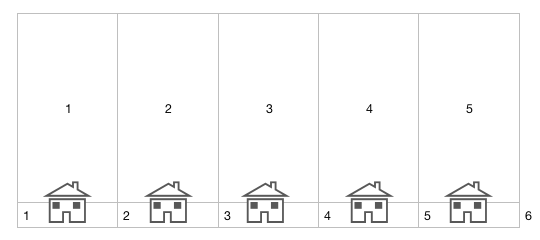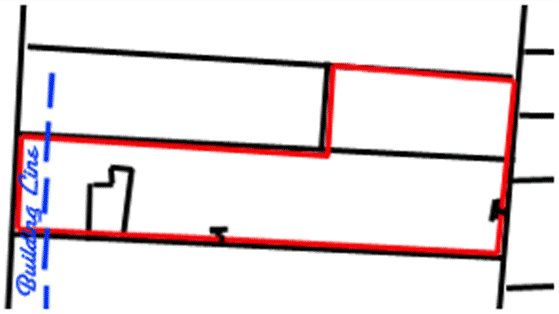Finding out who owns a fence
Contents
Article Summary
In England and Wales, there is no legal presumption that a person owns or must maintain a fence or other boundary barrier on the left or on the right. Ownership of the boundary is normally determined by the builder who erects the buildings. Modern buildings will usually have a detailed Transfer Deed that specifies ownership of the boundary fences. More often than not, however, it will be necessary to look at the ownership documents each side of the boundary, and sometimes even for the houses at the two ends of the street. These documents would include the Title Register, Title Plan, Associated Documents, Deed Plans, and, if Leasehold, the Lease and Lease Plan for each of the properties adjoining the boundary. These documents are all included in a Boundary Search.
Example of Boundary Fence Ownership in a Road
Where a developer creates 5 properties from a plot of land owned by him, there will be 4 dividing boundaries and 2 end boundaries (6 in all) as in the example below. This means that at least one of the properties will own at least 2 of the boundaries; thus there can be no presumptive rule of ownership on one side or the other.

T and H Marks
T marks on a plan do not indicate ownership of a fence, but only responsibility for it, e.g. where there is a covenant to keep it in good repair. It is often the case, however, that ownership follows but it is unsafe to rely on this without further evidence. The Land Registry do not normally include T marks in the Title Plan unless they have been requested to do so.

This sasmple shows T marks on two of a property's boundaries. The bars of the T clearly show the owner that is responsible to maintain the boundary structures, although it is not clear whether he is the owner of them.
Common Law Boundary Presumptions and Conventions relating to Boundary Structures
Fences
The following Boundary Presumptions or Conventions will normally apply, subject to rebuttal by evidence to the contrary:
- The fence is on the land of the fence owner. This means that the boundary will be presumed to be on the outer side of the fence.
- Struts. Where a fence has struts on one of its sides it is presumed that the owner of the fence is the owner of the land upon which the struts stand.
- Upright Posts. Where a fence is supported by upright posts on one side it is likewise presumed that the upright posts stand upon the fence owner's land.
- Fences with Footings. The Party Wall Act 1996 allows for a fence footing to be laid underground, partly under the adjoining property.
- Wooden Panel Fences. Where the wooden panels are fitted between the posts the convention is for the external face of the posts to be placed on the owner's land against or close to the boundary.
- Wire Fences. Where wire fences are supported by concrete posts the convention is for the outer face of the post to be against or close to the boundary, and for the wires to be passed through holes in the centre of the posts. Where the posts are of wood, the outer face would be against or close to the boundary and the wires would be stapled into the outer face of the post.
The Law of Property Act 1952 provides a statutory provision enabling a court order to be acquired where a fence adversely affects the adjoining property.
Walls
Where the boundary is a garden wall, ownership of that boundary is presumed to be on the side of the wall farthest from the garden of the owner who erected the wall. It is presumed that the owner would make certain to build with the external face on the edge of his own land.
Where the wall is a wall separating one house from another, e.g. where the house is terraced or semi-detached, ownership of it is dictated by the Party Walls Act 1996. There is a legal presumption that a party wall is jointly owned by each house owner, with the centre line being the boundary. This presumption can be rebutted where a Party Wall Notice has been agreed indicating a different ownership arrangement.
Where there is a dispute as to the height of a garden wall or fence there may be a restriction in the title register or the Associated Documents, which would be enforceable by applying to the county court for an injunction, should the height restriction be exceeded.
Boundary Search 2 Properties
Obtain all the available property documents held to help resolve common boundary problems. For 2 Adjoining Properties.
£99.95Boundary Search 3 Properties
Obtain all the available property documents held to help resolve common boundary problems. For 3 Adjoining Properties.
£146.95Boundary Search 4 Properties
Obtain all the available property documents held to help resolve common boundary problems. For 4 Adjoining Properties.
£193.95


